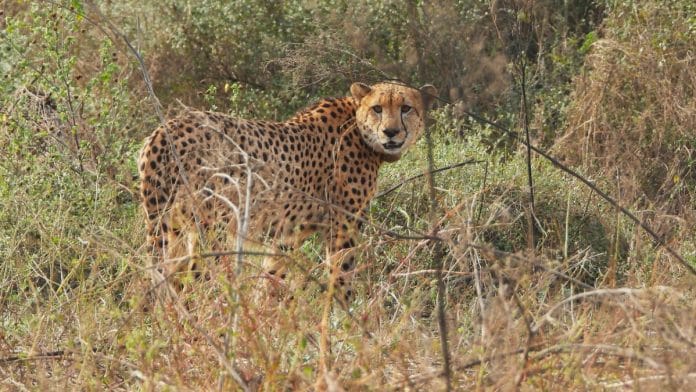Bhopal: The Madhya Pradesh government has begun work to develop the Nauradehi Wildlife Sanctuary as the third home for cheetahs in the state, after Kuno National Park and Gandhi Sagar Wildlife Sanctuary. A team of the National Tiger Conservation Authority (NTCA) inspected the sanctuary in May, and earmarked a 30 km area spread across three ranges of Mohli, Jhapa and Singpur to be prepared to house cheetahs.
A senior official from Madhya Pradesh’s forest department told ThePrint, “The team of National Tiger Conservation Authority gave a go-ahead to prepare the sanctuary to receive cheetahs.”
The expanse of Nauradehi is located on a plateau spread across Sagar and Damoh districts in the Bundelkhand region. While it has a deciduous forest with sal, teak, mahua, bamboo and bel trees in abundance, there are also extensive continuous grasslands, which act as grazing lands for herbivores, with a substantial prey base, including four different categories of antelopes, and other animals such as wild boar.
The forest department is also working to further augment this prey base with the translocation of cheetals or spotted deer from Pench and Kanha Tiger Reserves.
In 2010, Nauradehi was one of the priority sites considered for the reintroduction of cheetahs, but was later dropped, owing to the large number of villages that were yet to be relocated from within the sanctuary.
According to senior wildlife officials, there were a total of 93 villages at its core, of which 44 have been shifted outside, while 49 still remain within the sanctuary.
The forest department is currently undertaking the relocation of three more villages, while seven others, including Mohli village—one of the largest ones—will be taken up for relocation later this year.
The three ranges of Mohli, Jhapa and Singpur earmarked by the inspection team, comprising Vaibhav Mathur, deputy inspector general of forests at NTCA, have a total of 13 villages, which will be taken up for relocation. The 30 km area will also be fenced to reduce biotic pressure.
The divisional forest team has also sought an additional funding of Rs 150 crore for the relocation of these 13 villages. Nauradehi will also be equipped with veterinary doctors, filling up the vacant positions in the sanctuary.
After going extinct in India in 1952, cheetahs were brought back to the country in September 2022, when eight of them were flown in from Namibia to the Kuno National Park in the state’s Sheopur district.
Another batch of 12 was flown in from South Africa in February 2023. These were also housed at Kuno, taking the total number of cheetahs in India to 20. However, the Narendra Modi government’s Project Cheetah suffered a major setback the following monsoon, when several of them suffered infections, causing the death of eight males, bringing down the total number of adult cheetahs to 12.
Over the past two years, a total of 26 cubs were born to these cheetahs, but only 19 survived. With the 12 adults and 19 cubs, the total number of cheetahs in India currently stands at 31.
In April this year, two adult male cheetahs, Pawan and Prabhas, who were among the 12 cheetahs brought in from South Africa, were relocated to Gandhi Sagar Wildlife Sanctuary that has been developed as the second home for the big cats in the country.
The aim of developing more homes is to create a metapopulation of cheetahs at different locations in the country.
(Edited by Mannat Chugh)
Also Read: Mr India, Machli, Maya—Why India’s tiger reserves keep breaking the no-naming rule






